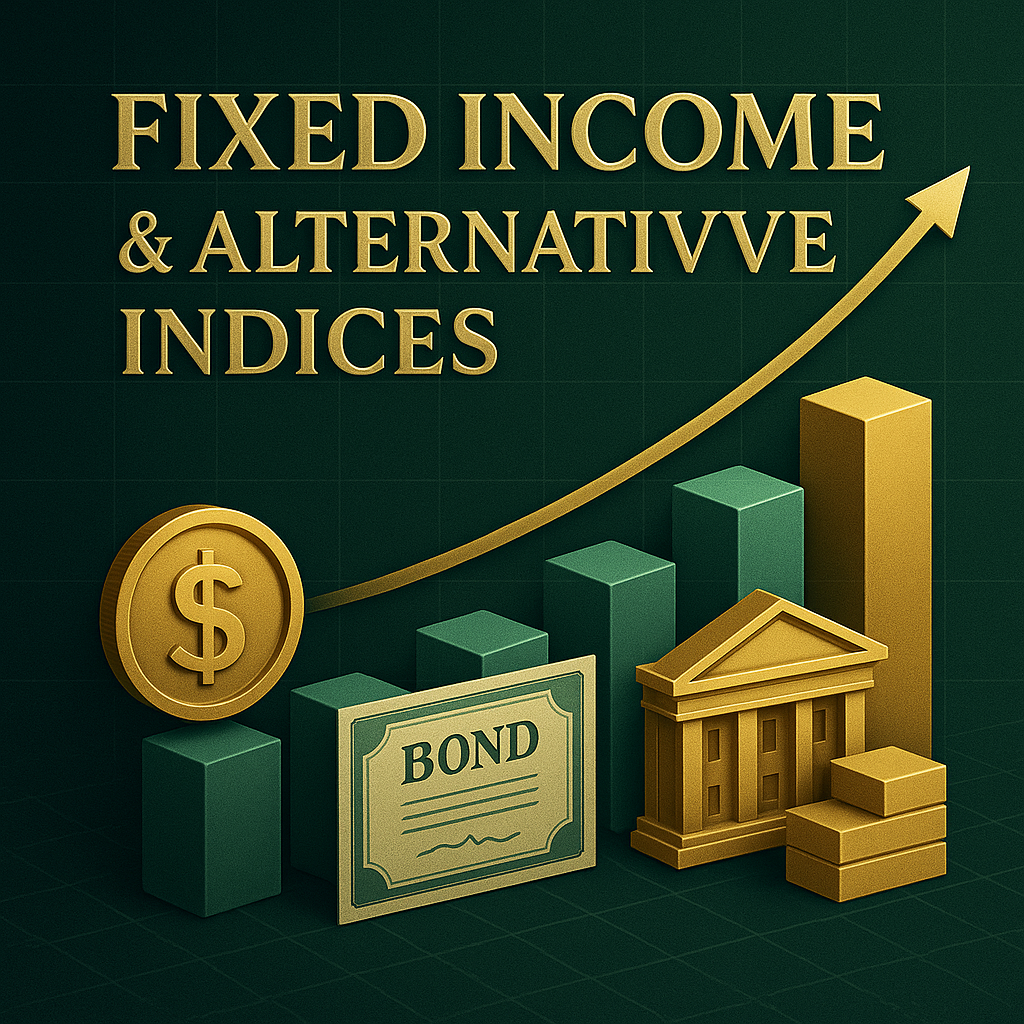Fixed Income & Alternative Indices benchmarks reach far beyond equities. Accordingly, this guide shows how bond, infrastructure, hedge-fund, and other non-equity indices are built; moreover, it explains why investors rely on them for portfolio construction; finally, it sketches where the next innovations are likely to emerge. Consequently, we walk through core concepts, representative indices, methodology highlights, typical use cases, and key strengths and limitations—so you can navigate the ever-expanding benchmark landscape with confidence.
1. Why Look Beyond Equities?
At first glance, stock indices such as the S&P 500 steal the spotlight. Nevertheless, global investors actually hold far more debt than equity, and pensions and endowments are increasingly targeting “alts” like infrastructure or hedge funds for diversification. Therefore, fixed-income and alternative indices serve as essential yard-sticks for risk management as well as performance reporting.
2. Fixed-Income Benchmarks at a Glance
| Segment | Flagship Index | Quick Facts | Transition Note |
|---|---|---|---|
| Investment-Grade Aggregate | Bloomberg US Aggregate | ~13 600 bonds, $28 T market value, market-value-weighted, updated daily | To begin with, the broadest U.S. yard-stick |
| Global Sovereigns | Bloomberg Global Aggregate | Tracks government and quasi-sovereign debt in 24+ currencies | Meanwhile, adds multi-currency reach |
| Emerging-Market Sovereigns | J.P. Morgan EMBI Global Diversified | Hard-currency bonds from 70+ EM issuers, capped by country size | By contrast, focuses on developing nations |
| Corporate Credit | J.P. Morgan Global Corporate | IG and HY corporate bonds across USD, EUR, GBP, and more | In addition, captures spread risk |
Because bonds mature, each index rolls its universe monthly; meanwhile, new issues enter after a short seasoning period, thus keeping duration profiles stable.

3. Alternative-Asset Benchmarks
- Infrastructure. S&P Global Infrastructure and Dow Jones Brookfield Global Infrastructure weight “pure-play” listed utilities, energy, and transport firms, thereby offering liquid proxies for real assets.
- Hedge Funds. The HFRI Fund-Weighted Composite aggregates ~2 000 single-manager returns, equal-weighting them and rebalancing monthly—hence providing an investible beta for the hedge-fund universe.
- Commodities & Real Assets. Broad baskets such as the Bloomberg Commodity Index or S&P GSCI roll futures exposure across energy, metals, and ags, thereby capturing spot-price trends with transparent rules.
- Private Credit & CLOs. Niche indices like the J.P. Morgan CLOIE track floating-rate loan pools, thus helping allocators benchmark yield and spread movements.
4. Construction Building Blocks
Although methodologies differ, most benchmarks share four design pillars:
- Universe Definition – clear rules on eligible issuers or assets; otherwise, inclusion becomes subjective.
- Weighting Scheme – market value, capped value, or equal weighting; alternately, liquidity or risk-parity overlays refine exposures.
- Rebalance Cadence – monthly for bonds (to absorb new issues), quarterly for listed infrastructure, and monthly/quarterly for hedge-fund composites; consequently, drift is minimized.
- Governance – independent committees, public rulebooks, plus IOSCO alignment to ensure data integrity.
5. How Investors Use Them
Because duration, credit spread, or Sharpe ratios vary widely across asset classes, allocators lean on the fixed-income and alternative indices explained here in order to:
- Benchmark Active Managers—for example, a core-bond fund versus the Bloomberg US Aggregate; thereafter, excess return is crystal-clear.
- Create Passive Products—ETFs, mutual funds, and total-return swaps track index rules mechanically; consequently, fees stay low.
- Risk Budgeting & Asset Allocation—CIOs map exposure buckets to each benchmark’s historical volatility; as a result, portfolios remain balanced.
- Regulatory Reporting—pension plans cite appropriate indices when disclosing performance to stakeholders; thus, compliance burdens ease.
6. Benefits & Limitations
| Benefits | Limitations |
|---|---|
| Transparent, rules-based yard-sticks guide both active and passive mandates. | However, market-cap weighting can overweight the largest debtors. |
| Daily pricing and long histories enable robust back-tests. | Meanwhile, illiquid or private assets may be under-represented. |
| Facilitate low-cost passive exposure, thereby broadening access. | Finally, methodology tweaks can shift risk metrics suddenly. |
7. Trends to Watch
- ESG & Climate Screens. Green-bond subsets and low-carbon infrastructure indices are proliferating; accordingly, sustainable mandates gain sharper tools.
- Factor-Tilted Bond Benchmarks. Duration-hedged and credit-quality-tilted variants help match liability streams; consequently, liability-driven investors benefit.
- Tokenized Debt Indices. On-chain baskets of T-bills or syndicated loans promise instant settlement; furthermore, they could slash operational friction.
- Blended Benchmarks. Multi-asset indices now merge fixed income with alts, thereby offering one-stop “60/40 2.0” reference points.
Key Takeaways
- Fixed Income and Alternative Indices explained: essential benchmarks span sovereign bonds, corporate credit, infrastructure equities, hedge-fund composites, and more.
- Design choices—universe, weighting, rebalance—therefore drive exposures and risks.
- Investors use these indices for benchmarking, passive replication, as well as strategic asset allocation.